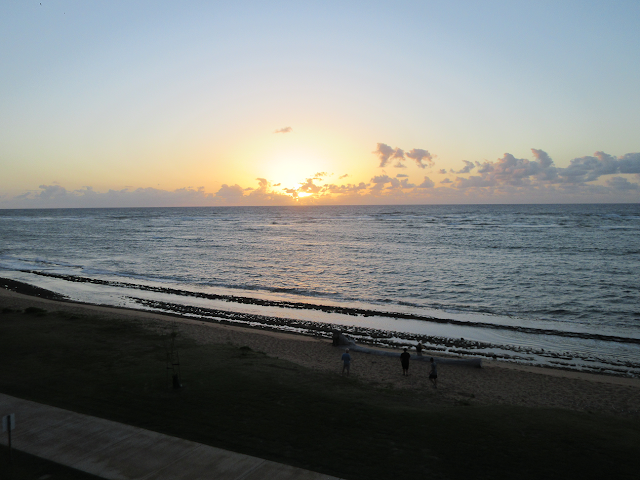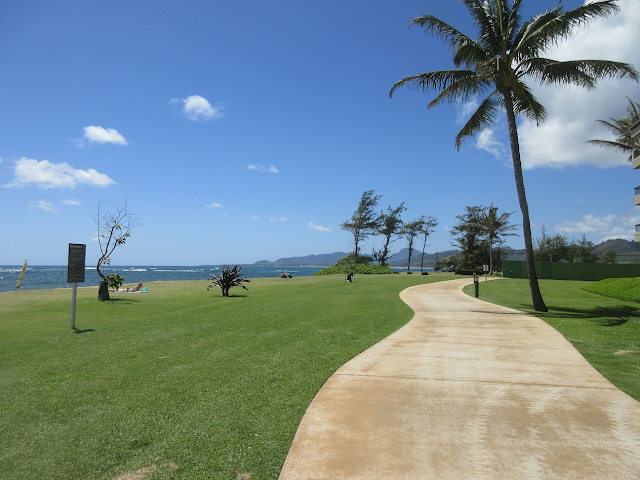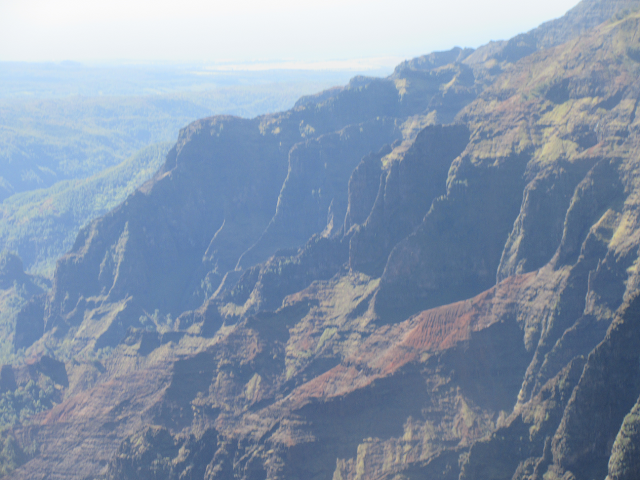Well, here I am, and the secret is out. My late winter holiday is a return to Hawai'i, which I last visited five years ago, in 2017.
Getting to Hawai'i is all about the jetlag for residents of eastern North America. It's no less than six time zones away from Toronto or anywhere on the U. S. east coast. I left my hotel in Toronto at 6:45 am on Friday, and after 3 flights and 2 stopovers of about 3 hours each (and several other hassles), I finally reached my hotel room in Kaua'i at 10:30 pm (which is 4:30 am in Toronto). Think of it -- over 24 hours in transit. Needless to say, I'm going to be living in a jet-lagged fog for quite a few days.
But it all became worth it when I woke up in the morning to this sunrise view from my room.
Honesty compels me to admit that I spent a fair chunk of my time in Kaua'i lounging by the pool, soaking up local colour in the lounge, and otherwise decompressing after two solid winters at home without a single hot day anywhere. But I did get out to see a few scenic highlights. Kaua'i has many.
Kaua'i, often called "The Garden Isle," is the oldest in geological time and the least developed of the four major Hawaiian Islands for tourism. That second point may not remain true for much longer. The mere fact that it is more rural and less built up seems to be attracting more and more visitors, competing for the available hotel rooms and driving up room rates accordingly. Comparable resorts in Kauai are selling for easily twice the cost of properties on Waikiki Beach in Honolulu. Five years ago, Kauai was notably cheaper than Waikiki.
One look at this map is enough to tell you that this is a rural island.
I'm referring, of course, to the one single road running all the way around island, State Highway 50/56, most of which is only two lanes wide. No freeways here! There is one major airport at Lihu'e, with a runway long enough to accommodate medium-size twin-engine flights from North America. The secondary airport at Princeville can handle inter-island flights on smaller light twin aircraft and helicopters.
The three main resort areas are Princeville in the north, Kapa'a and Wailua in the east, and Poipu on the south shore. I'm staying at the Sheraton Coconut Beach Resort in Kapa'a. Here are a few pictures of the property to give you an impression.
In the last picture above, the wide paved walkway/cycle path marks the limit of the hotel property. To the left of the path is public land, including the beach, since by state law there is no such thing in Hawai'i as a private beach (except for beaches inside military reserves). There's a public beach access point on the south side of the hotel.
A fourth-floor corridor window on the landward side of the hotel gives this panorama of the island's mountainous interior, all of which has eroded down over untold millions of years from the two primordial volcanoes which gave birth to Kaua'i. On the far left side, behind the nearer peak and partly hidden in clouds (a normal condition) is the summit of Wai'ale'ale, the highest mountain on the island, and one of the wettest places on the entire planet.
We've barely got started, and it's time to begin language lessons.
Yes, I know that the apostrophe is actually turned around and has another special name but we're not going to get too technical here.
My first full day was spent just lazing around the pool, the restaurant, the bar, the pool, the bar.... Well, you get the picture. I still keep feeling sleepy at the weirdest times on the clock, thanks to the six-hour time zone displacement. On the other hand, simply lazing around the pool is very good for the soul in its own way.
On my second day, I went for a drive. Kaua'i is one island where a rental vehicle becomes essential, to put it mildly. Distances look deceptively small on the map. Also, traffic increasingly poses problems, especially in and around Lihu'e. So it took me almost exactly one hour to drive from Kapa'a all the way around to Kekaha and Highway 552. Along the way, I took a brief stop at the overlook for the Hanapepe Valley. You have to be alert, it's easy to miss on the highway.
Why not Highway 550 from Waimea? There are road signs directing people to use 552, and I would say with good reason. From Waimea up to the junction with 552, Highway 550 is one of the most sadistic roads I have ever driven. It has grades and bends that would do justice to a modern roller coaster, and is especially nasty at the upper end where you hit incredibly steep downgrades whichever way you're going, as the road climbs in and out of several deeply-gouged stream valleys. Highway 552 may take a bit longer, and cover a few more miles, but it's positively civilized by comparison. Certainly, anyone unused to driving mountain highways is better off to do the slightly longer route via Kekaha.
Either way, by all means stop for a few minutes in Waimea to have a look around at the unique historical architecture of the main street, rather than just driving through.
As a bonus, if you carry on to Kekaha you get this distant, enticing view, just before entering the town, of the so-called "forbidden island," Ni'ihau, to the southwest of Kaua'i.
Here's a link where you can read something of the fascinating history of Ni'ihau on Wikipedia -- it's quite the eye-opening story.
After you turn onto Highway 552, another twenty minutes of steady climbing brings you to the first main viewpoint in Waimea Canyon State Park. Here you will purchase admission and parking passes to the park at a ticket machine, which accepts only credit cards. For car and driver, not residents of Hawai'i, the fee is $15, with $5 additional for each further passenger. Similar ticket machines can be found at all major parking areas, and by April 19, 2022 all will be updated to sell both admission and parking tickets.
You will also, almost certainly, encounter Kaua'i's dominant form of "wildlife" if you haven't already done so -- the hordes of feral roosters, hens, and chickens. The crowing of roosters is a common background sound all over the island.
These clucking, crowing critters are almost everywhere in Kaua'i, and the song of the roosters runs from before sunrise all throughout the day.
Once you've paid your fee, you are covered for all parking areas in Waimea Canyon State Park and Koke'e State Park, both of which you will certainly visit while you are up on this mountain to begin with. Yes, it's a mountain. You are well over 3,000 feet above sea level, and the temperature -- which was 75F at Waimea -- dropped to somewhere between 60F and 64F, and held that level consistently throughout my visit. The main lookout points all have handicapped-access viewpoints.
With that, here are some choice pictures of the breathtaking Waimea Canyon, which is itself not far short of 3,000 feet deep. No wonder it's called "the Grand Canyon of the Pacific."
Look in the distance at the top left of this next picture. That height of land seen far away is Wai'ale'ale, seen from miles away and, for once, not covered with rain clouds. It's about 2000 feet (600+ metres) higher than the Canyon viewpoint. I think this was the first time I'd ever seen the mountain in the clear in three visits to Kaua'i.
It's a challenge photographing the canyon from the west side. In the morning, you are facing the sun, which explains why some of the pictures can look a bit washed out. Come back in the afternoon, and the canyon might not even be there any more if the rain has moved in.
Who knows, you might even encounter this particular "wild" critter, although that's a different story from the poultry.
After visiting the Canyon lookouts, you continue up the road and into Koke'e State Park. But be warned! After you pass Koke'e Lodge, the road has a number of rough spots, with one stretch so bad that matters have gone far beyond the "pothole" stage. I think they should borrow the name of a scenic road on the Big Island, and call that bit of road the "Chain of Craters."
Eventually you arrive at two more lookout points which offer differing views of the Kalalau Valley as it stretches downwards to the north shore of the island, again well over 3000 feet below you. This is the famous Na pali Coast. There is no road access along the Na pali Coast, only a tough hiking trail, and so less athletic visitors have to view it from the edges, as it were, or from a tour boat or helicopter. By the way, "pali" is the Hawaiian word for "cliff." You can see why.
By the way, you mustn't be surprised if you drive all the way up those twisting mountain roads to find one or more (or all) viewpoints socked in with fog, cloud, and rain. It can happen, but I've been lucky on each of my three visits to the Canyon -- or so it seems. It's not all luck. After only a few days in Hawai'i, or any other tropical island, you will soon learn that sunshine is more prevalent in the morning but afternoons often cloud over. I've always driven up to the Canyon as early in the morning as I can go. You should too.
More active visitors should certainly check out the opportunities for trail hiking in both parks.
After that set of breathtaking photo calls, I headed back down the mountain, and turned east, then south to the next destination, in the Poipu resort area on the south shore.
Doesn't look very exciting? Wait till you see the interior.
"Restaurant meets Theme Park." Most restaurants look for an exciting or beautiful location to set up shop. Keoki's Paradise built its own. To all appearances a tropical jungle miles from nowhere, what you are actually seeing is an artificial garden which backs directly onto the main road through Poipu. There are a few seats in the bar area from which you can see the odd vehicle through gaps in the trees. Otherwise, the only clue comes when some especially loud motorcycle or hot rod guns its engine in the middle of the forest.
So in I went, and was ushered to a table neatly tucked in between two boulders of volcanic rock emerging from the floor.
I was there for the Sunday brunch, so I missed out on the fresh fish which is the specialty of the house at dinner time -- as they say in their menu, "The fresh Hawaiian fish we serve are available according to their season
in keeping with Hawaiian fishing traditions and respect for the sea
(kai)." On the other hand, weekend brunch is one of the times they feature live music, and the singer was a definite asset to the meal.
The setting becomes even more magical at night, when tiki torches are lit and a few carefully placed lights among the trees highlight key features of the gardens. Some people might call it kitschy. I find it a refreshing change from the loud canned music in most restaurants, the endless repetitions of certain basic dishes like wings, fries, ribs, pizza, and the like. Keoki's Paradise is different, and I value that difference -- especially when every meal in this setting feels like an event. It's my one must-visit restaurant destination in Kaua'i and never disappoints.
Just talking about it is enough to make me hungry! I'm going to knock off now to look for some dinner, and post this before I go, because this marks the end of my Kaua'i adventures. Tomorrow, I'm off to Honolulu and the world-famous Waikiki Beach. See you there!

























No comments:
Post a Comment